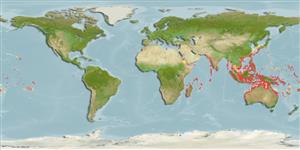>
Gobiiformes (Gobies) >
Gobiidae (Gobies) > Gobiinae
Etymology: Valenciennea: From Achille Valenciennes 1794-1865; he worked with Duméril, Cuvier and Lacepède since 1815; malacologist, author of a "Histoire naturelle des poissons" (Ref. 45335).
Eponymy: Achille Valenciennes (1794–1865) was a French zoologist; primarily an ichthyologist and conchologist. [...] W F C van Helsdingen was a Dutch civil servant, who provided Bleeker with a number of well-preserved fishes from the Gorong Archipelago (Indonesia), including the type of this goby. (Ref. 128868), visit book page.
More on author: Bleeker.
Environment: milieu / climate zone / rango de profundidad / distribution range
Ecología
marino asociado a arrecife; rango de profundidad 1 - 45 m (Ref. 48637), usually 1 - 30 m (Ref. 27115). Tropical; 22°C - 27°C (Ref. 27115); 44°N - 29°S, 32°E - 138°W
Indo-West Pacific: southern Red Sea (Ref. 34105) and East Africa (where common, Ref. 9710) to Indonesia, north to southern Japan (Ref. 9710), south to the Great Barrier Reef (Ref. 2334).
Tamaño / Peso / Age
Madurez: Lm ? range ? - ? cm
Max length : 25.0 cm TL macho / no sexado; (Ref. 9002); common length : 18.0 cm TL macho / no sexado; (Ref. 9002)
Espinas dorsales (total) : 7; Radios blandos dorsales (total) : 11; Espinas anales: 1; Radios blandos anales: 11. Characterized by pale grey body color with broad white midlateral stripe bordered by pair of black to brownish stripes; first dorsal fin with large black spot; truncate to slightly emarginate caudal fin, ray above and below central three rays prolonged as filament in adult; length of caudal fin 2.4-5.0 in SL; longitudinal scale series 127-146; ctenoid body scales except cycloid on abdomen; head or midline of nape without scales; in adult, cycloid scales extending forward on side of nape to above middle of operculum; base of pectoral fin and prepelvic area scaled in adult; depth of body 5.0 in SL (Ref. 90102).
Body shape (shape guide): fusiform / normal.
A relatively rare species occurring singly but usually in pairs over silty flat sand patches, or rubble substrates; a mound-building species. Usually found on outer reefs at the bottom of coral or rocky drop-offs, rarely in lagoons. Feeds on small burrowing animals by sifting mouthfuls of sand. Monogamous (Ref. 34105, 48637, 52884). Eggs hatched 2 days after spawning in aquaria; 35 days after, the larvae reached 5.25 mm.
Life cycle and mating behavior
Madurez | Reproducción | Puesta | Huevos | Fecundidad | Larva
Monogamous mating is observed as both obligate and social (Ref. 52884).
Hoese, D.F. and H.K. Larson, 1994. Revision of the Indo-Pacific gobiid fish genus Valenciennea, with descriptions of seven new species. Indo-Pac. Fish. (23):71 p. (Ref. 8527)
IUCN Red List Status (Ref. 130435: Version 2025-1)
Threat to humans
Harmless
Human uses
Pesquerías: comercial; Acuario: Comercial
Herramientas
Special reports
Download XML
Fuentes de Internet
Estimates based on models
Preferred temperature (Referencia
123201): 24.4 - 29, mean 27.6 °C (based on 1254 cells).
Phylogenetic diversity index (Referencia
82804): PD
50 = 0.5000 [Uniqueness, from 0.5 = low to 2.0 = high].
Bayesian length-weight: a=0.01023 (0.00477 - 0.02194), b=3.01 (2.83 - 3.19), in cm total length, based on LWR estimates for this (Sub)family-body shape (Ref.
93245).
Nivel trófico (Referencia
69278): 3.4 ±0.41 se; based on food items.
Resiliencia (Referencia
120179): Medio, población duplicada en un tiempo mínimo de 1.4-4.4 años (Preliminary K or Fecundity.).
Fishing Vulnerability (Ref.
59153): Low vulnerability (15 of 100).
🛈
Nutrients (Ref.
124155): Calcium = 59.9 [33.5, 106.4] mg/100g; Iron = 0.603 [0.321, 1.046] mg/100g; Protein = 18.6 [16.8, 20.3] %; Omega3 = 0.138 [0.068, 0.217] g/100g; Selenium = 27.6 [16.5, 48.3] μg/100g; VitaminA = 100 [30, 283] μg/100g; Zinc = 1.38 [0.98, 1.96] mg/100g (wet weight);
